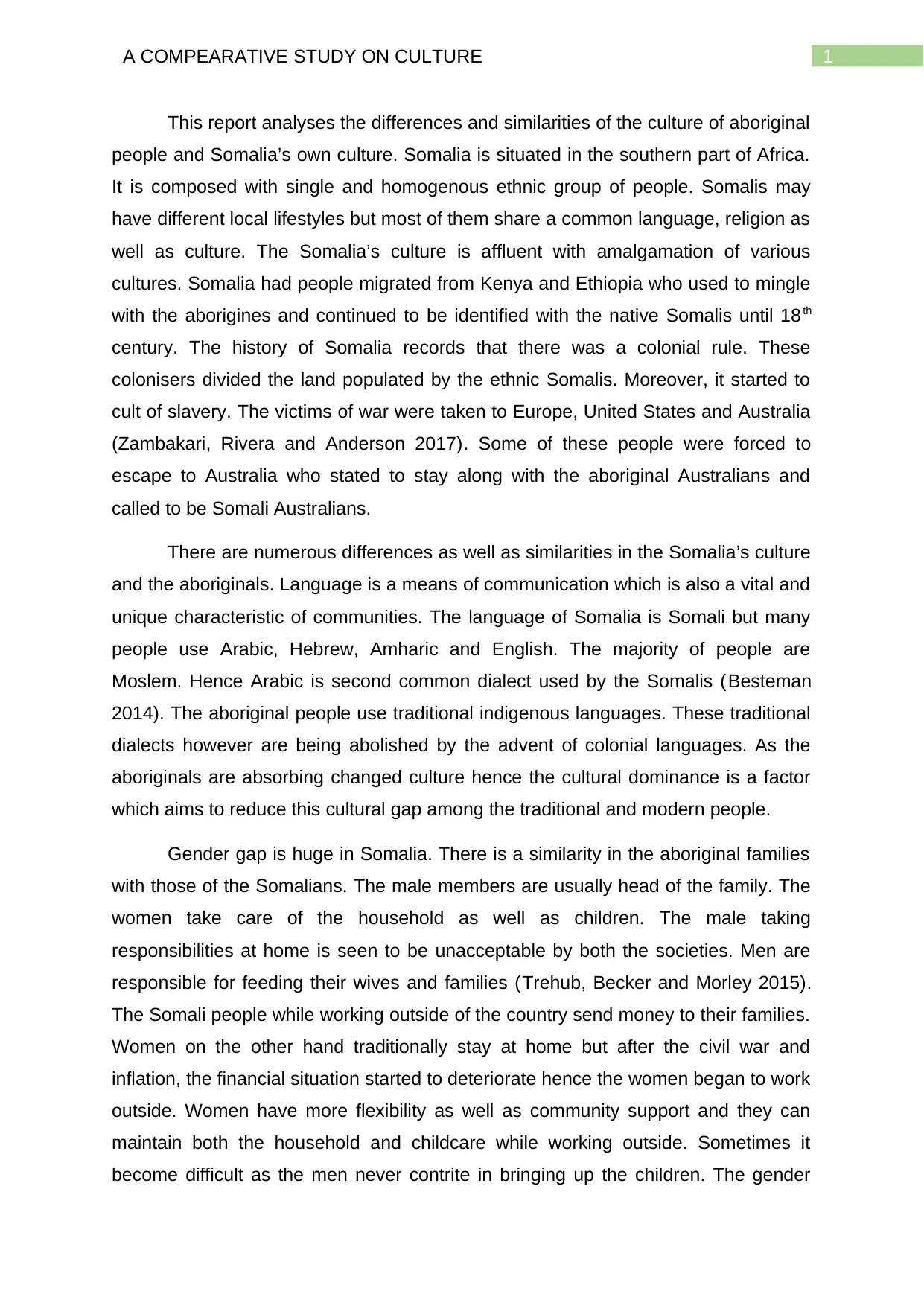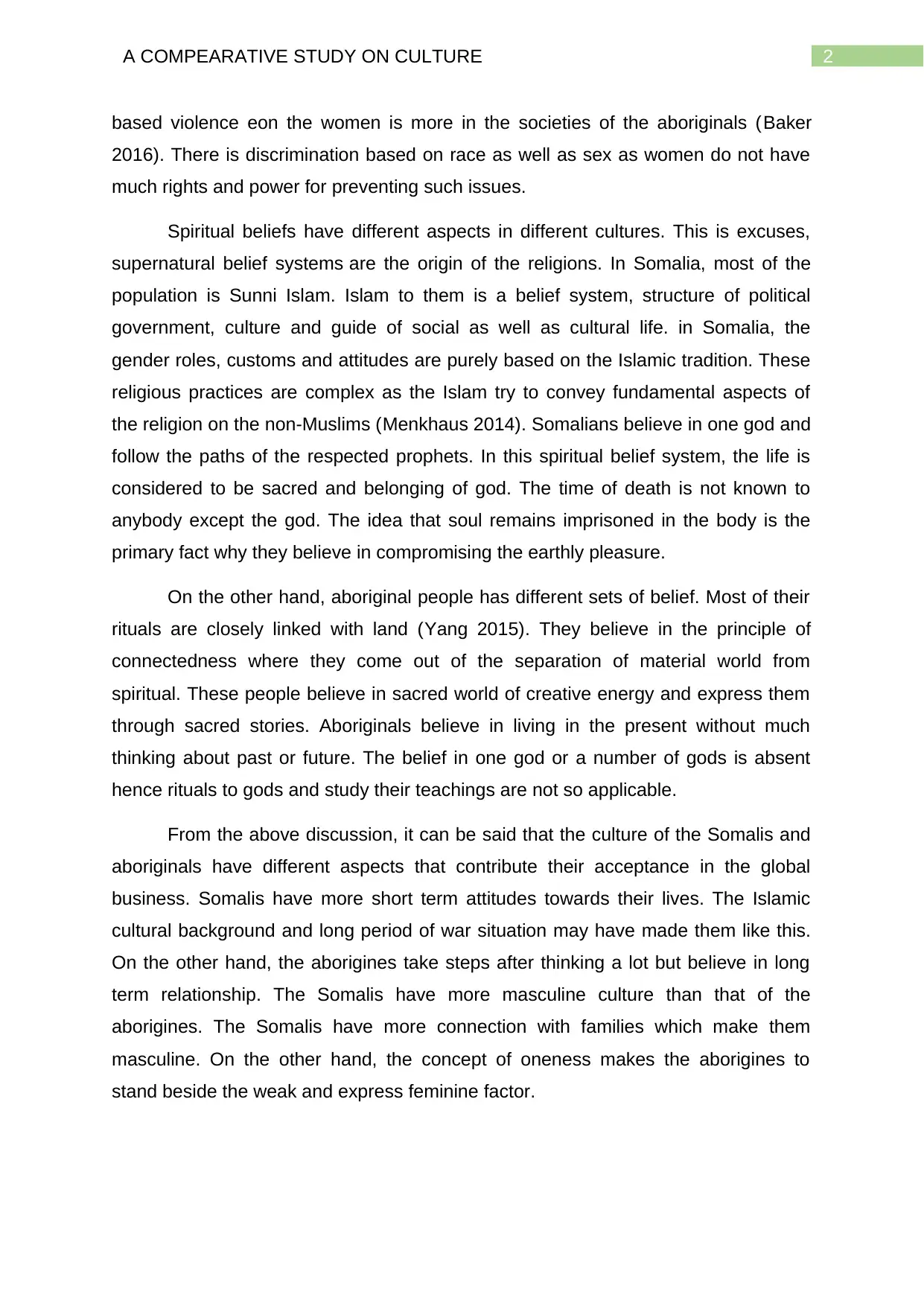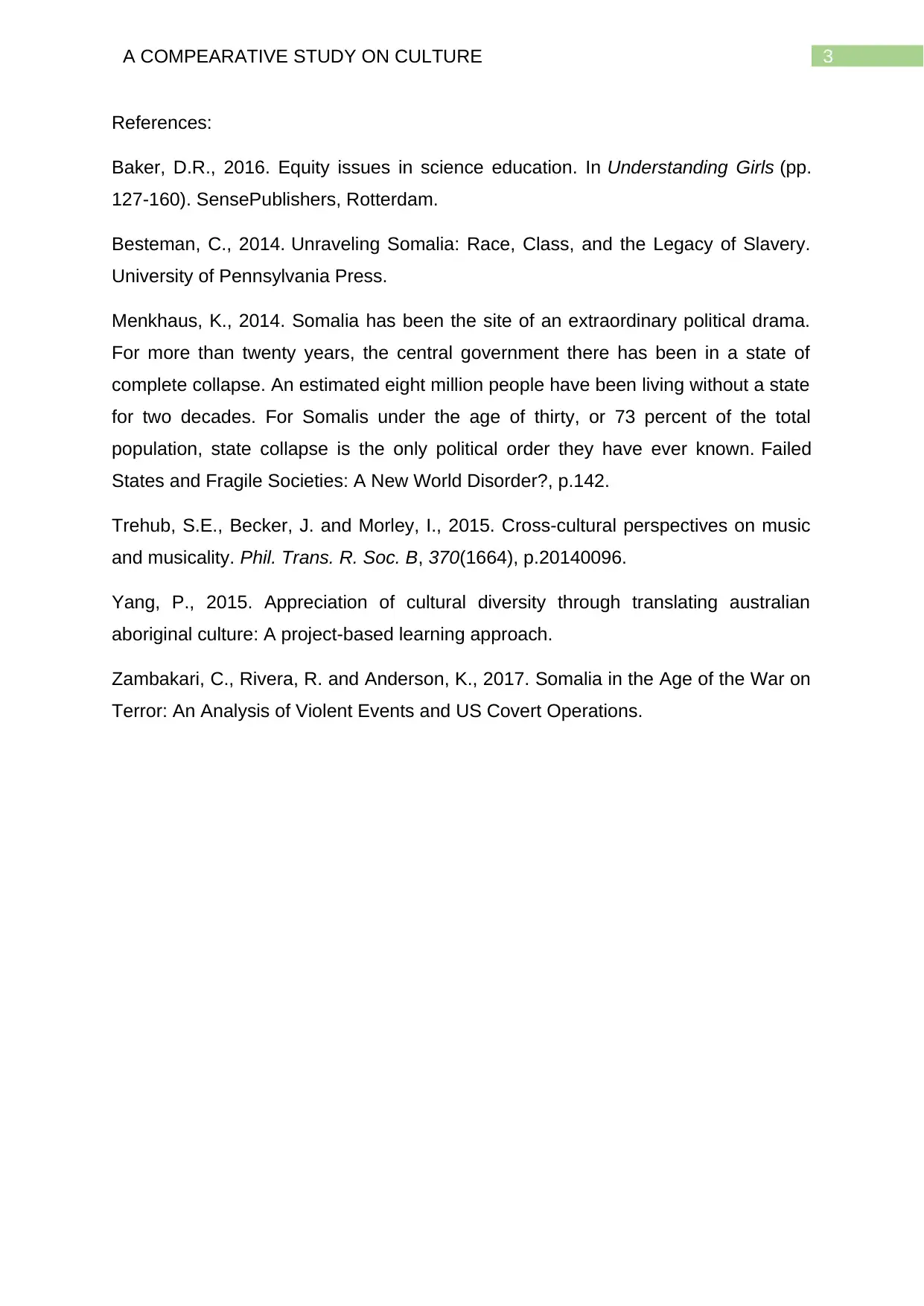A Comparative Study on Culture: Somalia vs. Aboriginal People
VerifiedAdded on 2021/04/17
|4
|1178
|65
Report
AI Summary
This report presents a comparative study of the cultures of Somalia and Aboriginal people, focusing on their languages, gender roles, and spiritual beliefs. The analysis highlights the differences and similarities between the two cultures, including the influence of Islam in Somalia and the traditional indigenous languages and spiritual practices of the Aboriginal people. The report examines the role of gender, family structures, and the impact of colonialism and globalization on these cultures. It also discusses the attitudes towards life, masculinity, and femininity within each society. The study uses various references to support its findings, providing a comprehensive overview of the cultural aspects and their acceptance in a global business context.

Running head: A COMPEARATIVE STUDY ON CULTURE
A COMPEARATIVE STUDY ON CULTURE
Name of the student:
Name of University:
Author Note:
A COMPEARATIVE STUDY ON CULTURE
Name of the student:
Name of University:
Author Note:
Paraphrase This Document
Need a fresh take? Get an instant paraphrase of this document with our AI Paraphraser

1A COMPEARATIVE STUDY ON CULTURE
This report analyses the differences and similarities of the culture of aboriginal
people and Somalia’s own culture. Somalia is situated in the southern part of Africa.
It is composed with single and homogenous ethnic group of people. Somalis may
have different local lifestyles but most of them share a common language, religion as
well as culture. The Somalia’s culture is affluent with amalgamation of various
cultures. Somalia had people migrated from Kenya and Ethiopia who used to mingle
with the aborigines and continued to be identified with the native Somalis until 18th
century. The history of Somalia records that there was a colonial rule. These
colonisers divided the land populated by the ethnic Somalis. Moreover, it started to
cult of slavery. The victims of war were taken to Europe, United States and Australia
(Zambakari, Rivera and Anderson 2017). Some of these people were forced to
escape to Australia who stated to stay along with the aboriginal Australians and
called to be Somali Australians.
There are numerous differences as well as similarities in the Somalia’s culture
and the aboriginals. Language is a means of communication which is also a vital and
unique characteristic of communities. The language of Somalia is Somali but many
people use Arabic, Hebrew, Amharic and English. The majority of people are
Moslem. Hence Arabic is second common dialect used by the Somalis (Besteman
2014). The aboriginal people use traditional indigenous languages. These traditional
dialects however are being abolished by the advent of colonial languages. As the
aboriginals are absorbing changed culture hence the cultural dominance is a factor
which aims to reduce this cultural gap among the traditional and modern people.
Gender gap is huge in Somalia. There is a similarity in the aboriginal families
with those of the Somalians. The male members are usually head of the family. The
women take care of the household as well as children. The male taking
responsibilities at home is seen to be unacceptable by both the societies. Men are
responsible for feeding their wives and families (Trehub, Becker and Morley 2015).
The Somali people while working outside of the country send money to their families.
Women on the other hand traditionally stay at home but after the civil war and
inflation, the financial situation started to deteriorate hence the women began to work
outside. Women have more flexibility as well as community support and they can
maintain both the household and childcare while working outside. Sometimes it
become difficult as the men never contrite in bringing up the children. The gender
This report analyses the differences and similarities of the culture of aboriginal
people and Somalia’s own culture. Somalia is situated in the southern part of Africa.
It is composed with single and homogenous ethnic group of people. Somalis may
have different local lifestyles but most of them share a common language, religion as
well as culture. The Somalia’s culture is affluent with amalgamation of various
cultures. Somalia had people migrated from Kenya and Ethiopia who used to mingle
with the aborigines and continued to be identified with the native Somalis until 18th
century. The history of Somalia records that there was a colonial rule. These
colonisers divided the land populated by the ethnic Somalis. Moreover, it started to
cult of slavery. The victims of war were taken to Europe, United States and Australia
(Zambakari, Rivera and Anderson 2017). Some of these people were forced to
escape to Australia who stated to stay along with the aboriginal Australians and
called to be Somali Australians.
There are numerous differences as well as similarities in the Somalia’s culture
and the aboriginals. Language is a means of communication which is also a vital and
unique characteristic of communities. The language of Somalia is Somali but many
people use Arabic, Hebrew, Amharic and English. The majority of people are
Moslem. Hence Arabic is second common dialect used by the Somalis (Besteman
2014). The aboriginal people use traditional indigenous languages. These traditional
dialects however are being abolished by the advent of colonial languages. As the
aboriginals are absorbing changed culture hence the cultural dominance is a factor
which aims to reduce this cultural gap among the traditional and modern people.
Gender gap is huge in Somalia. There is a similarity in the aboriginal families
with those of the Somalians. The male members are usually head of the family. The
women take care of the household as well as children. The male taking
responsibilities at home is seen to be unacceptable by both the societies. Men are
responsible for feeding their wives and families (Trehub, Becker and Morley 2015).
The Somali people while working outside of the country send money to their families.
Women on the other hand traditionally stay at home but after the civil war and
inflation, the financial situation started to deteriorate hence the women began to work
outside. Women have more flexibility as well as community support and they can
maintain both the household and childcare while working outside. Sometimes it
become difficult as the men never contrite in bringing up the children. The gender

2A COMPEARATIVE STUDY ON CULTURE
based violence eon the women is more in the societies of the aboriginals (Baker
2016). There is discrimination based on race as well as sex as women do not have
much rights and power for preventing such issues.
Spiritual beliefs have different aspects in different cultures. This is excuses,
supernatural belief systems are the origin of the religions. In Somalia, most of the
population is Sunni Islam. Islam to them is a belief system, structure of political
government, culture and guide of social as well as cultural life. in Somalia, the
gender roles, customs and attitudes are purely based on the Islamic tradition. These
religious practices are complex as the Islam try to convey fundamental aspects of
the religion on the non-Muslims (Menkhaus 2014). Somalians believe in one god and
follow the paths of the respected prophets. In this spiritual belief system, the life is
considered to be sacred and belonging of god. The time of death is not known to
anybody except the god. The idea that soul remains imprisoned in the body is the
primary fact why they believe in compromising the earthly pleasure.
On the other hand, aboriginal people has different sets of belief. Most of their
rituals are closely linked with land (Yang 2015). They believe in the principle of
connectedness where they come out of the separation of material world from
spiritual. These people believe in sacred world of creative energy and express them
through sacred stories. Aboriginals believe in living in the present without much
thinking about past or future. The belief in one god or a number of gods is absent
hence rituals to gods and study their teachings are not so applicable.
From the above discussion, it can be said that the culture of the Somalis and
aboriginals have different aspects that contribute their acceptance in the global
business. Somalis have more short term attitudes towards their lives. The Islamic
cultural background and long period of war situation may have made them like this.
On the other hand, the aborigines take steps after thinking a lot but believe in long
term relationship. The Somalis have more masculine culture than that of the
aborigines. The Somalis have more connection with families which make them
masculine. On the other hand, the concept of oneness makes the aborigines to
stand beside the weak and express feminine factor.
based violence eon the women is more in the societies of the aboriginals (Baker
2016). There is discrimination based on race as well as sex as women do not have
much rights and power for preventing such issues.
Spiritual beliefs have different aspects in different cultures. This is excuses,
supernatural belief systems are the origin of the religions. In Somalia, most of the
population is Sunni Islam. Islam to them is a belief system, structure of political
government, culture and guide of social as well as cultural life. in Somalia, the
gender roles, customs and attitudes are purely based on the Islamic tradition. These
religious practices are complex as the Islam try to convey fundamental aspects of
the religion on the non-Muslims (Menkhaus 2014). Somalians believe in one god and
follow the paths of the respected prophets. In this spiritual belief system, the life is
considered to be sacred and belonging of god. The time of death is not known to
anybody except the god. The idea that soul remains imprisoned in the body is the
primary fact why they believe in compromising the earthly pleasure.
On the other hand, aboriginal people has different sets of belief. Most of their
rituals are closely linked with land (Yang 2015). They believe in the principle of
connectedness where they come out of the separation of material world from
spiritual. These people believe in sacred world of creative energy and express them
through sacred stories. Aboriginals believe in living in the present without much
thinking about past or future. The belief in one god or a number of gods is absent
hence rituals to gods and study their teachings are not so applicable.
From the above discussion, it can be said that the culture of the Somalis and
aboriginals have different aspects that contribute their acceptance in the global
business. Somalis have more short term attitudes towards their lives. The Islamic
cultural background and long period of war situation may have made them like this.
On the other hand, the aborigines take steps after thinking a lot but believe in long
term relationship. The Somalis have more masculine culture than that of the
aborigines. The Somalis have more connection with families which make them
masculine. On the other hand, the concept of oneness makes the aborigines to
stand beside the weak and express feminine factor.
⊘ This is a preview!⊘
Do you want full access?
Subscribe today to unlock all pages.

Trusted by 1+ million students worldwide

3A COMPEARATIVE STUDY ON CULTURE
References:
Baker, D.R., 2016. Equity issues in science education. In Understanding Girls (pp.
127-160). SensePublishers, Rotterdam.
Besteman, C., 2014. Unraveling Somalia: Race, Class, and the Legacy of Slavery.
University of Pennsylvania Press.
Menkhaus, K., 2014. Somalia has been the site of an extraordinary political drama.
For more than twenty years, the central government there has been in a state of
complete collapse. An estimated eight million people have been living without a state
for two decades. For Somalis under the age of thirty, or 73 percent of the total
population, state collapse is the only political order they have ever known. Failed
States and Fragile Societies: A New World Disorder?, p.142.
Trehub, S.E., Becker, J. and Morley, I., 2015. Cross-cultural perspectives on music
and musicality. Phil. Trans. R. Soc. B, 370(1664), p.20140096.
Yang, P., 2015. Appreciation of cultural diversity through translating australian
aboriginal culture: A project-based learning approach.
Zambakari, C., Rivera, R. and Anderson, K., 2017. Somalia in the Age of the War on
Terror: An Analysis of Violent Events and US Covert Operations.
References:
Baker, D.R., 2016. Equity issues in science education. In Understanding Girls (pp.
127-160). SensePublishers, Rotterdam.
Besteman, C., 2014. Unraveling Somalia: Race, Class, and the Legacy of Slavery.
University of Pennsylvania Press.
Menkhaus, K., 2014. Somalia has been the site of an extraordinary political drama.
For more than twenty years, the central government there has been in a state of
complete collapse. An estimated eight million people have been living without a state
for two decades. For Somalis under the age of thirty, or 73 percent of the total
population, state collapse is the only political order they have ever known. Failed
States and Fragile Societies: A New World Disorder?, p.142.
Trehub, S.E., Becker, J. and Morley, I., 2015. Cross-cultural perspectives on music
and musicality. Phil. Trans. R. Soc. B, 370(1664), p.20140096.
Yang, P., 2015. Appreciation of cultural diversity through translating australian
aboriginal culture: A project-based learning approach.
Zambakari, C., Rivera, R. and Anderson, K., 2017. Somalia in the Age of the War on
Terror: An Analysis of Violent Events and US Covert Operations.
1 out of 4
Related Documents
Your All-in-One AI-Powered Toolkit for Academic Success.
+13062052269
info@desklib.com
Available 24*7 on WhatsApp / Email
![[object Object]](/_next/static/media/star-bottom.7253800d.svg)
Unlock your academic potential
Copyright © 2020–2025 A2Z Services. All Rights Reserved. Developed and managed by ZUCOL.





